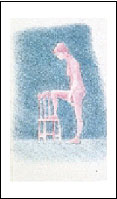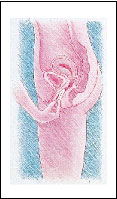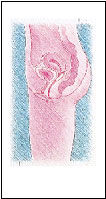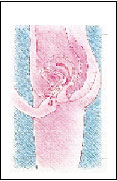7.5 micrograms / 24 hours vaginal insert
estradiol
What Oestring is and what it is used for
Oestering belongs to a group of medicines called vaginal hormone replacement therapy ( HRT ).
Oestering is used to relieve local vaginal problems, such as dryness and irritation, when menstruation ceases during menopause ( menopause ). In medical terms, this is called “vaginal atrophy”. It is caused by estrogen levels in the body falling after menopause. The symptoms can cause pain during intercourse, itching, burning discomfort, recurrent urinary tract infections, urinary incontinence, and pain when urinating.
Oestering works by replacing the estrogen that is normally produced in a woman’s ovaries. Oestering is introduced into the vagina so the hormone is released where it is needed, which can relieve discomfort in the vagina.
Registration releases a small amount of estradiol (7.5 micrograms per day) inside the vagina for 90 days.
You need to talk to a doctor if you do not feel better or if you feel worse.
What you need to know before using Oestring
Do not use Oestring
if any of the following apply to you. If you are not sure about any of the following, talk to your doctor before using Restring.
Do not use Oestring:
- if you have or have had breast cancer , or you are suspected of having breast cancer
- if you have or have had cancer that is sensitive to estrogen , such as cancer of the uterine lining (endometrium) or if there is a suspicion of such cancer
- if you have any unexplained genital bleeding
- if you have severe thickening of the uterine lining ( endometrial hyperplasia ) and have not been treated for it
- if you have or have had a blood clot in a vein (venous thromboembolism ), for example in the legs (deep vein thrombosis ) or the lungs ( pulmonary embolism )
- if you have a coagulation disorder (eg protein C, protein S or antithrombin deficiency)
- if you have or have recently had a disease caused by blood clots in your arteries , such as a heart attack , stroke or angina
- if you have or have had a liver disease and your liver values have not returned to normal
- if you have “porphyria”, a rare inherited blood disorder
- if you are allergic to estradiol or any of the other ingredients of this medicine (see section 6)
Note that Oestring is a drug that has an effect locally in the abdomen and that the amounts of estradiol that are absorbed by the body are very low. If any of the above conditions occur for the first time while you are taking Oestring, stop using it immediately and consult a doctor.
Medical history and regular check-ups
The use of HRT carries risks that you should consider before deciding whether to start treatment or continue ongoing treatment.
There is only limited experience of treatment for women where menstruation has stopped prematurely (due to ovarian failure or surgery). If your period has stopped prematurely, the risks of HRT may be different. Talk to your doctor.
Before starting treatment (or resuming treatment), your doctor will ask about your own, and your family’s, medical history. Your doctor may do a general medical and gynecological examination, which also includes an examination of your breasts.
Once you have started treatment with Oestring, you should have regular medical check-ups (at least once a year). During these check-ups, you should discuss with your doctor the benefits and risks of continuing treatment with Oestring.
Perform regular examinations of the breasts according to the doctor’s recommendations.
Warnings and cautions
Tell your doctor if you have ever had any of the following problems before starting treatment, as they may come back or get worse during treatment with Oestring. Should this occur, have more frequent check-ups with a doctor.
- muscle knots ( fibroids ) inside the uterus
- uterine lining that grows outside the uterus ( endometriosis ) or a previous strong growth of the uterine lining ( endometrial hyperplasia )
- increased risk of developing blood clots (see “Blood clot in a vein ( thrombosis )”)
- increased risk of developing estrogen-sensitive cancer (if, for example, your mother, sister or grandmother had breast cancer)
- ovarian cancer
- high blood pressure
- liver disease, such as a benign liver tumor
- diabetes
- gallstone
- migraine or severe headache
- a disease of the immune system that affects many organs in the body (systemic lupus erythematosus, SLE )
- epilepsy
- asthma
- a disease that affects the eardrum and hearing (otosclerosis)
- a very high level of fat in the blood ( triglycerides er)
- fluid retention due to heart or kidney problems
It has happened that the ring is attached to the vaginal wall and has been difficult to remove, contact a doctor if this occurs.
You should contact your doctor immediately and discontinue treatment with Oestring if any of the following occur:
- any of the conditions mentioned in the section “Do not use Oestring”
- skin or whites of the eyes turn yellow (jaundice); it may be a sign of liver disease
- your blood pressure rises sharply (symptoms may include headache, fatigue, dizziness)
- if you are experiencing migraine-like headaches for the first time
- if you become pregnant
- if you notice signs of a blood clot, such as:
- painful swelling and redness of the legs
- sudden chest pain
- breathing difficulties
For more information, see below “Blood clots in a vein ( thrombosis )”.
Note: Oestering is not a contraceptive. If it has been less than 12 months since you had your last period or you are younger than 50 years, you may need to use additional contraception to prevent pregnancy. Ask your doctor for advice.
HRT and cancer
Severe thickening of the uterine lining ( endometrial hyperplasia ) and cancer of the uterine lining (endometrial cancer).
Use of HRT in tablet form with estrogen alone for a long time may increase the risk of developing cancer of the uterine lining (endometrium).
It is unclear whether there is a corresponding risk when Oestring is used for repeated or long-term (over a year) treatment. However, it has been shown that Oestring has a very low absorption into the blood and therefore no addition of a progestin is required.
If you have a breakthrough or splash bleeding, there is usually nothing to worry about, but you should contact your doctor. It may be a sign that your uterine lining has become thicker.
The following risks apply to hormone replacement therapy ( HRT ) circulating in the blood. Oestering, on the other hand, is used topically in the vagina and the uptake into the blood is very low. The conditions described below are unlikely to worsen or return during treatment with Oestring, but you should consult a doctor if you are concerned.
Breast cancer
There are indications that the use of Oestring does not increase the risk of breast cancer in women who have not had breast cancer before. It is unknown whether Oestring can be used safely in women who have had breast cancer before.
For women without a uterus who have therefore only taken estrogen, there is no, or small, increased risk of breast cancer.
Check your breasts regularly. Contact a doctor if you notice changes such as:
- pits in the skin
- changes of the nipple
- nodules that you can see or feel.
It is also recommended that you participate in all mammography examinations when called upon to do so.
Ovarian cancer ( ovarian cancer )
Ovarian cancer is uncommon – much rarer than breast cancer. The use of HRT with estrogen alone has been associated with a slightly increased risk of ovarian cancer.
The risk of ovarian cancer varies with age. Of, for example, women aged 50 to 54 who do not take HRT, approximately 2 women out of 2,000 will be diagnosed with ovarian cancer over a 5-year period.
For women who take HRT for 5 years, there will be about 3 cases per 2,000 users (ie about 1 extra case).
How HRT affects the heart and blood circulation
Blood clot in a friend ( thrombosis )
The risk of blood clots in the veins is about 1.3 to 3 times higher for women who use HRT than those who do not, especially during the first year of treatment.
Blood clots can be serious. If a blood clot ends up in the lungs, it can cause chest pain, shortness of breath, and lead to fainting or even death.
You are more likely to get a blood clot if you are older and if any of the following apply to you. Tell your doctor if any of the following apply to you:
- you can not walk for a long time due to a major operation, injury or illness (see also section 3, “If you need surgery”)
- you are severely overweight ( BMI over 30 kg / m 2 )
- you have a coagulation disorder that requires long-term treatment with drugs to prevent blood clots
- one of your close relatives has had a blood clot in your leg, lung or other organ
- you have systemic lupus erythematosus ( SLE )
- you have cancer
The section “You should contact a doctor immediately and discontinue treatment with Oestring if any of the following occur” describes signs of a blood clot.
Comparison
For women in their 50s who do not take HRT, over a 5-year period, an average of 4 to 7 women out of 1,000 are expected to get a blood clot in a vein.
For women in their 50s who have taken HRT with estrogen alone for more than 5 years, 5 to 8 cases per 1,000 users are expected to have a blood clot in a vein (ie 1 extra case).
Heart disease (heart attack)
For women who receive treatment with estrogen alone, there is no increased risk of developing heart disease.
Stroke _
The risk of stroke is about 1.5 times higher for women who use HRT compared to those who do not. The risk of stroke is age-dependent, therefore the number of cases of stroke increases due to the use of HRT with increasing age.
Comparison
For women in their 50s who do not take HRT, an average of 8 out of 1,000 are expected to have a stroke over a 5-year period. For women in their 50s who have taken HRT for more than 5 years, 11 out of 1,000 users are expected to have a stroke (ie 3 extra cases).
Other conditions
- Using HRT does not prevent memory loss. The risk of memory loss may be slightly higher in women who start taking HRT after the age of 65. Consult your doctor.
- Use of systemic HRT may cause or worsen the symptoms of angioedema , especially if you have hereditary angioedema (hereditary form of angioedema ). Contact a doctor immediately if you get any of the following symptoms ( angioedema ):
- swelling of the face, tongue or throat
- difficulty swallowing
- hives and difficulty breathing
Other medicines and Oestring
Tell your doctor or pharmacist if you are taking, have recently taken, or might take any other medicines, including medicines obtained without a prescription, herbal medicines, or other natural products.
Because Oestring is used for topical treatment in the vagina, it is unlikely that Oestring will affect the effectiveness of other medicines. Registration can affect the effectiveness of other treatments given vaginally.
Pregnancy, breastfeeding and fertility
Oestering is intended for women whose menstruation has stopped. If you become pregnant, stop using Oestring and consult a doctor.
If you are pregnant or breastfeeding, think you may be pregnant, or are planning to have a baby, ask your doctor or pharmacist for advice before taking this medicine.
Driving and using machines
Oestering has no known effects on the ability to drive or use machines.
How to use Oestring
Always use this medicine exactly as your doctor or pharmacist has told you. Ask your doctor or pharmacist if you are unsure.
Your doctor will strive to prescribe the lowest dose that treats your symptoms, for as short a time as possible. Talk to your doctor if you think your dose is too high or too low.
The ring is compressed into an oval shape and inserted into the vagina, follow the instructions for use below.
After a couple of weeks, the ring works with full effect. The ring is allowed to remain for 90 days and must then be replaced and replaced with a new one. This is repeated every three months. Treatment with Oestring can continue as long as you find it meaningful and your doctor agrees.
Instructions for use
To insert the ring:
Insert the ring into the vagina as follows:
Stand with one foot on a chair, squat, or lie on your back in bed with your legs apart.

Squeeze the ring into an oval

Insert the ring inside the vaginal opening

If the ring falls out?
The ring can slide down the vagina and become noticeable after, for example, visiting the toilet. If the ring falls out, rinse it in lukewarm water (not hot) and then insert it into the vagina, as described on the previous page.
How should the ring be removed?
After 90 days, the ring should be replaced.
You should remove the ring as follows:
- Stand with one foot on a chair.
- Insert a finger into the vagina and hook it around the ring.
- Pull out the ring.

What should I do with the ring after use?
For environmental reasons, do not flush the ring down the toilet. It is best to put the used ring in the packaging and return it to the pharmacy for disposal (see also “Storage and shelf life”). It is also acceptable for environmental and safety reasons to dispose of the used ring together with your other household waste for combustible waste.
Practical information:
For most women and their partners, the ring does not cause any problems during intercourse. If you and your partner find the ring uncomfortable, it can be removed before intercourse and then put back into the vagina.
You can replace the ring yourself, but if you find it difficult, you can get help from a nurse, midwife, or doctor.
If you use more Oestring than you should
If you have used too much medicine or if e.g. a child ingested the medicine by mistake, contact a doctor or hospital for risk assessment and advice.
If you stop using Oestring
If you stop treatment, your symptoms may return after a few weeks.
If you need surgery
If you are going to have surgery, tell your surgeon that you are using Oestring. You may need to stop using Oestring for 4 to 6 weeks before surgery to reduce the risk of blood clots (see section 2, Blood clot in a vein). Ask your doctor when you can start using Oestring again.
If you have any further questions on the use of this product, ask your doctor or pharmacist.
Possible side effects
Like all medicines, this medicine can cause side effects, although not everybody gets them.
The following diseases have been reported more frequently for women taking HRT drugs circulating in the blood compared to women not taking HRT. These risks are less for drugs used vaginally, such as Oestring:
- ovarian cancer
- blood clots in the veins of the legs or lungs (venous thromboembolism )
- stroke _
- probable memory loss if HRT is started over the age of 65
More information on these side effects can be found in section 2.
At the beginning of the treatment, you may have increased discharge.
Common (may affect up to 1 in 10 people): Urinary tract infection, irritation/itching/infection in the vagina, abdominal pain, abdominal discomfort, rectal discomfort, headache, nausea, itching, pronounced sweating, irritated bladder, unexpected abdominal bleeding.
Uncommon (may affect up to 1 in 100 people): Tension in the breasts, accumulation of fluid in the tissue, feeling of pressure in the abdomen, hypersensitivity reactions.
Rare (may affect up to 1 in 1,000 people): Ulcers of the vaginal mucosa.
Has been reported (occurs in an unknown number of users): Difficulty removing the ring due to the ring attaching to the vaginal wall (see section Warnings and precautions).
Many of the above side effects go away within a couple of weeks.
In case of unexpected genital bleeding, consult a doctor.
The following side effects have been reported with other HRT medicines that are taken up in the bloodstream:
- diseases of the gallbladder
- various skin problems:
- discoloration of the skin, especially on the face or neck called “pregnancy spots” (chloasma)
- painful red nodules (erythema nodosum)
- rash that looks like red, sore “targets” (erythema multiforme)
How to store Oestring
Keep this medicine out of the sight and reach of children.
No special storage instructions.
Do not use this medicine after the expiry date which is stated on the carton after EXP. The expiration date is the last day of the specified month. The ring can be inserted at any time until the expiration date and left in the vagina for 90 days.
Unused medicines should not be disposed of via wastewater or household waste. For environmental and safety reasons, unused, leftover, or too old rings must be left at the pharmacy for disposal.
Contents of the pack and other information
Content declaration
- The active substance is estradiol hemihydrate 2 mg.
- The other ingredients are silicone elastomer Q7-4735 A, silicone elastomer Q7-4735 B, divinylpolydimethylsiloxane and barium sulphate.
What the medicine looks like and contents of the pack
Oestring vaginal insert is an elastic, slightly opaque ring that is packed in a foil bag.
Each carton contains 1 vaginal insert.
Marketing Authorization Holder and Manufacturer
Pfizer AB
191 90 Sollentuna
Tel: 08-550 520 00
Email: eumedinfo@pfizer.com